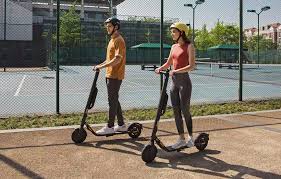Transport in cities is in the process of evolution and e-scooters can be considered as the leaders in this process. Nowadays, cities of the world face various challenges such as traffic jams, polluted environment, and people’s need for environmentally friendly transport; thus, an innovative solution has appeared – electric scooters. This paper aims to reveal key features of e-scooters and their influence on urban mobility, understand their positive effects, and also examine the changes they bring to the cities.
The Emergence of Electric Scooters in Cities
Self-driving electric scooters, like those from Unagi Scooters, are one of the newest means of transport that has gained significant acceptance in urban areas over the recent past. Recent advancements in technologies, pollution, and congestion awareness together with the need for high mobility in urban areas have given rise to e-scooters. Fluent in the streets of San Francisco and Paris, electric scooters are changing the ways people get around.
They have found that one of the major reasons for the adoption of e-scooters is the micro-mobility solutions. These lighter electrically operated transport systems provide a more versatile solution as compared to the car and bus systems. In the short hops, chores, or pleasure trips, e-scooters offer a convenient way of commuting that is cheap and effective.
Eco-Friendly and Sustainable Transportation Solution
Unagi Scooters are making a positive impact on the overall usage of transport systems in urban areas, especially in the following ways; With the current efforts to have cities decrease their output of carbon emissions, the e-scooter is a more environmentally friendly approach to the normal gasoline-operated scooters. They operate on electricity, which can be gotten from renewable sources of energy meaning that they don’t emit any gases when in use.
These scooters have a positive attitude towards environmental impact when compared with traditional means of transport like cars since they do not pollute the air and cause traffic congestion. With more persons using e-scooters, the dependency on fossil fuel-borne transport is reduced, hence leading to better environmental standards in cities.
In the same manner, electric scooters take compact spaces in roads and parking areas, thus making them plausible for congested cities that have chronically suffered from limited parking spaces. The use of e-scooters offers tremendous benefits if well implemented can help cities to be pedestrian-friendly, and eventually reduce urbanization.
Cost-Effective Commuting Option
Electric scooters are a cost-effective alternative to other modes of urban transportation, making them accessible to a wide range of people. For city dwellers looking to cut down on commuting expenses, e-scooters offer an attractive option. The cost of purchasing an e-scooter is relatively low compared to owning a car, and for those who prefer not to invest in ownership, many cities offer scooter-sharing services, allowing users to rent scooters for short-term use.
Scooter-sharing services operate through mobile apps, making it easy for users to find, unlock, and pay for their rides using a smartphone. This pay-as-you-go model is highly convenient and affordable, especially for people who only need transportation for short distances. Users can avoid the costs associated with car ownership, such as fuel, maintenance, and insurance, while still benefiting from an efficient and flexible mode of transport.
Moreover, electric scooters typically have lower operational and maintenance costs compared to cars or motorcycles, thanks to their simple mechanical design and electric motors. As a result, e-scooters are becoming a popular choice for urban residents looking to save money on their daily commutes.
Reducing Traffic Congestion in Cities
One of the most pressing issues in urban transportation is traffic congestion. As cities grow and more vehicles hit the roads, traffic jams become increasingly common, leading to wasted time, higher fuel consumption, and elevated stress levels for commuters. Electric scooters offer a solution to this problem by providing a nimble, compact, and agile mode of transportation that can easily navigate through congested streets.
Since e-scooters are smaller than cars and can travel in bike lanes, they help ease traffic flow by reducing the number of larger vehicles on the road. By promoting the use of electric scooters, cities can alleviate some of the pressure on their transportation networks, leading to shorter travel times and a more efficient commute for all road users.
Additionally, electric scooters are particularly useful for “last-mile” transportation. Many commuters face the challenge of getting from public transit stops to their final destination. E-scooters fill this gap by offering a convenient and quick way to cover short distances that may not be well-served by buses or trains. This reduces the need for car trips and promotes a more integrated and efficient urban transportation system.
Enhancing Mobility and Accessibility
Electric scooters are helping to bridge the mobility gap in urban areas, offering greater accessibility to people who may not have access to a car or public transportation. For individuals living in densely populated areas, e-scooters provide a convenient way to move around without relying on limited or crowded public transit options.
The introduction of electric scooters has also made transportation more accessible for people with mobility challenges. Many e-scooters are designed with ease of use in mind, featuring intuitive controls, adjustable settings, and a lightweight design that makes them easy to maneuver. This allows individuals who may have difficulty walking long distances to navigate urban environments more comfortably.
By improving mobility for a diverse range of users, e-scooters contribute to a more inclusive transportation network that serves the needs of all city residents.
Urban Planning and Infrastructure Adaptation
The rapid growth of electric scooters has prompted cities to rethink their urban planning and transportation infrastructure. As more people turn to e-scooters for their daily commutes, cities are investing in infrastructure improvements to accommodate this new mode of transport.
Many cities are expanding their network of bike lanes and shared paths to create safer environments for e-scooter riders. Dedicated scooter lanes and parking areas are also being introduced to reduce conflicts with pedestrians and other vehicles. By integrating e-scooters into existing transportation systems, cities can create a more cohesive and sustainable urban mobility network.
In addition to physical infrastructure changes, city governments are implementing regulations to ensure the safe and responsible use of electric scooters. These regulations often include speed limits, parking restrictions, and safety requirements such as helmets. By establishing clear guidelines for e-scooter use, cities can promote safer streets and encourage responsible riding behavior.
Conclusion
Electric scooters are revolutionizing urban transportation by offering an eco-friendly, cost-effective, and convenient solution to the challenges faced by modern cities. They reduce traffic congestion, lower emissions, and enhance mobility for a wide range of users. As cities continue to adapt their infrastructure and embrace new technologies, e-scooters are poised to play a critical role in the future of urban transportation. By supporting the growth of electric scooters, cities can create more sustainable, efficient, and accessible transportation networks for all residents.



